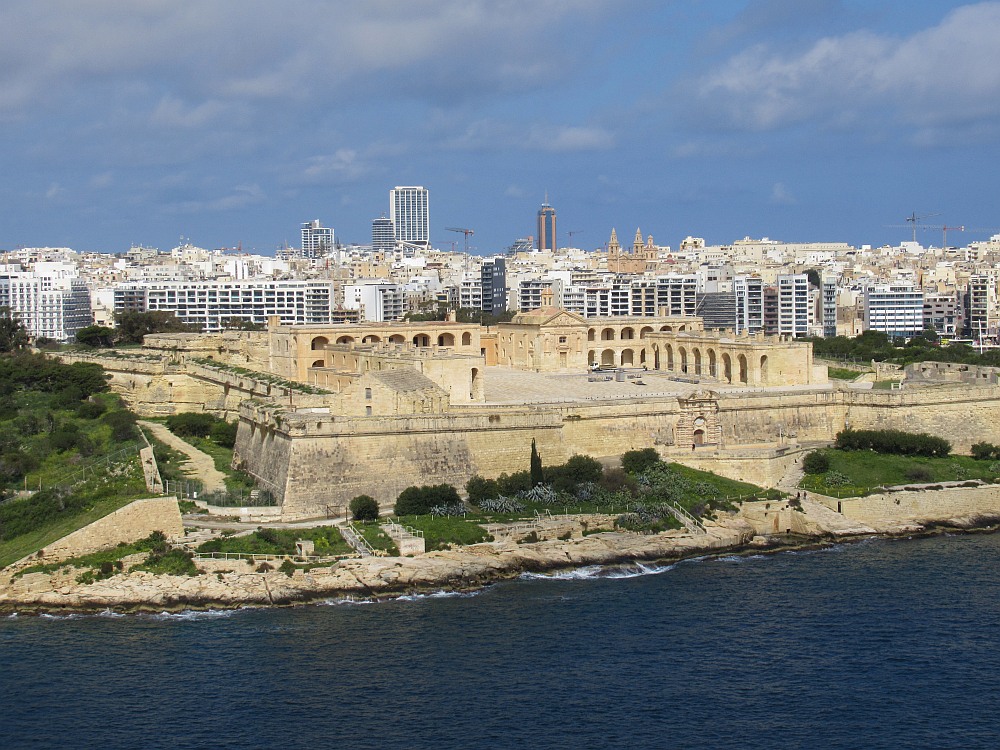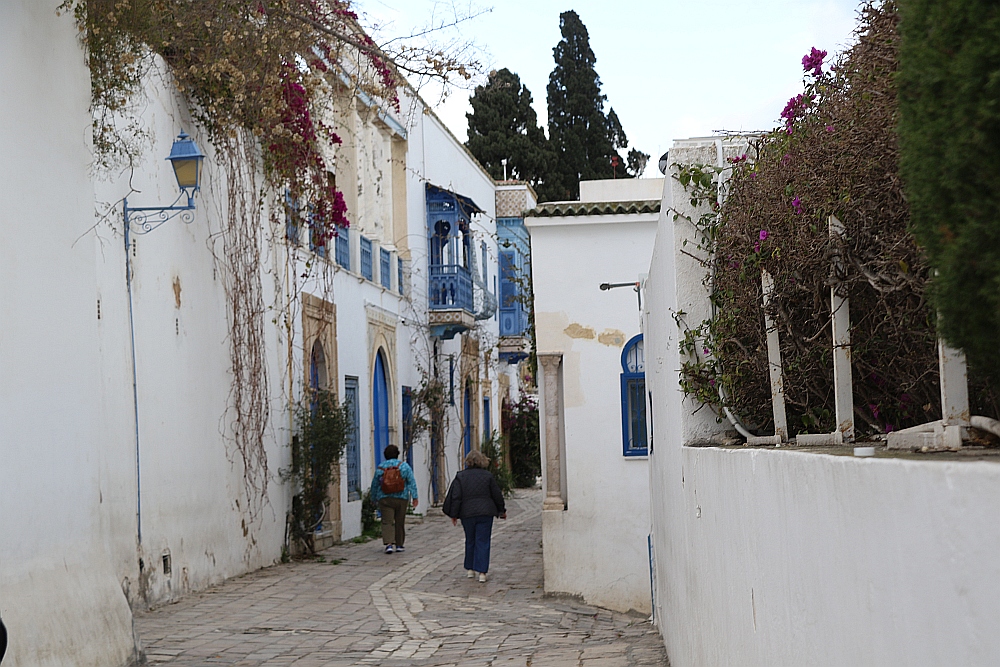Tunisia-Med-Sahara Day 2
Tunisia-Med-Sahara
Day 08-03 - Tuesday, March 17, 2009 - City Tour and Bardo Museum/Visit Sidi Bou Said/Explore Ancient Carthage/Visit North Africa American Cemetery/Visit Sidi Bou Said
We were back to a reasonable wake-up call – our alarm got us up at 6:30am. Breakfast was back on the first floor where we had our wonderful buffet last night.
The sumptuousness of the breakfast selection here in this hotel was a pleasant surprise and change from the morning meals in Marrakech.
The air was cooler today at 62º and 77% humidity. Most of the local people wore heavy coats and jackets on their way to work. Khamis greeted us with the traditional morning wishes for a beautiful day. The fog seemed to have burnt off so we had promises of a bright day.
We left the city heading northwest past busy floral shops and followed the TGM train line. Khamis gave us a running commentary of the surrounding area.
We passed the city of La Goulette, a predominately French and Jewish Community during pre-war years. June 1, 1955 is known as Victory Day, the day of Independence of Tunisia from France.
Spain also occupied the country for about 50 years. In 1492 the Muslims were expelled from the Iberian Peninsula which is just as significant as the Columbus discovery of America in our historical calendar.
We arrived at ancient ruins of Carthage, the City of Death according to the Romans. We heard the story of romance and tragedy of the legendary era of Queen Dido and Aeneas chronicled in Virgil's Aeneid.
The scattered ruins helped us envision where the mighty city of antiquity once stood, sending its fleets for trade and warfare across the Mediterranean. We viewed the Punic military harbor where over 220 ships could dock.
We stopped at the place of the Phoenician child sacrifices - The Tophet. We were able to walk through the stelea, almost like tombstones marking the sites of the urns containing the remains of the first born. Recent studies have found that the Phoenicians also sacrificed older children and even adults.
The next exciting activity was the Roman baths. The huge site occupied over 35,000 square meters. There were two symmetrical sections, one for the men and one for women. Ancient texts say that there was a lattice work, wooden screen separating the two halves.
Seeing the original floor plan and the model of the reconstruction gave us an idea of the immensity and opulence of the structure. We had only about 45 minutes to explore and then we were on our way again.
We continued our tour of Tunis and the surrounding cities seeing the theatre and then the Basilica of St. Louis. Beside the Basilica were the Carthage Museum and the Punic remains.
From the top of the hill we could see the harbor, the circus where they held the games, and the baths. The Romans destroyed Carthage in the war, but came back to occupy it under Julius Caesar in the first century BC.
The excavated Punic homes were unique as they had running water and toilets in each house. The Romans used public baths and latrines, but the Phoenicians were more private.
Gennie bought a few post cards and stamps at the museum gift shop and we were back on the bus at 11:15. Our next brief stop was at the Carthage cisterns where the Romans stored the water they brought over 128 miles from the Zaguan Mountains through the aqueducts.
We saw the ruins of Carthage and the Roman ruins. Our next stop was also a somber one. Khamis took us to the North Africa American Cemetery in Carthage.
The site covers over 27 acres and is one of 11 American WWII Cemeteries in the world. There were 2841 crosses and/or Star of David markers signifying the sacrifices in the North African campaign against German General Erwin Rommel. Names engraved on the wall are the 3,724 missing in action.
A gentleman from the US government office of Battlefields and Monuments Commission gave us a brief overview of this memorial. At noon bells played the Star Spangled Banner and a bugler played Taps.
We journeyed to the seaside village of Sidi Bou Said, a feast for the eyes with its houses painted in deep blue and gleaming white. Set on a hill with a sweeping view of the Gulf of Tunis, this picturesque town has drawn artists and writers.
Our lunch was in a very unique restaurant, The Mamie Lily, the last of the Jewish establishments in the Arab countries not counting Morocco.
The owner of the establishment, Jacob Lellouche gave us a welcome and explained our meal of a starter salad, chicken with a lemon and mint sauce and rice. Our dessert was sweetened fruit with a baked meringue. As in Morocco, we finished with a glass of mint tea.
After our lunch Riadh drove us back to the city of Tunis to visit the Bardo Museum. This is Tunisia's national museum of archaeology. It is located in an 18th-century royal palace and we saw a spectacular collection of ancient Roman mosaics along with sarcophagi and statues from the Roman and Carthaginian periods.
Our last stop of the day was a stroll through the city's medina, (city built by the Arabs). There were many small specialty shops. We enjoyed watching Gharbi Jalloul who made the Tunisian Chechia or round red felt hats.
We also saw the men who made the Turkish Coffee and perfumers who blended different fragrances to make individually created bouquets.
We finished our walk back at the C Gate, and then walked back to the hotel. Our laundry had arrived so we organize our bags and then typed the journal before getting a bite to eat out on the Avenue François.
Accommodations: Africa Hotel - - - Meals: B, L
If you wish to travel with OAT Click Here.
To receive up to $200 per person off your first reservation with OAT, mention the following information when reserving your Overseas Adventure Travel Trip: Mr. Victor Garcia Customer #673062
Comments
While in Bavaria, WG, I visited the Desert Fox's grave--responsible for those crosses at American Cemetery. Deja vue.
quite a somber day of history lessons. but i enjoyed the hat production video and loved the photo from sidi bou said!
Post a Comment!American Battle Monuments Commission I studied it because General Davis was on the commission in the late 1940s and early 1950s when many of the World War 2 monuments were going through the design stage.
Featured Journal
Day 18: Mediterranean Navigation
Day 18 - Wednesday, March 19, 2025 – Disembark Ship & Return to USA
It was a dark and rainy morning when we put our luggage outside of our cabin door at 4:15. We met three of our fellow passengers also on the same flight...










